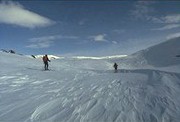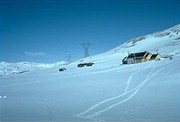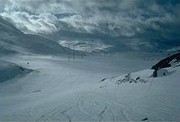

Hut to hut touring in Norway
 Hut touring is a superb way of getting the maximum out of one or two weeks skiing in spectacular mountain surroundings. There is a special satisfaction in the continuity of hut touring that day tours lack. It does have disadvantages, however. It is physically strenuous since you are committed to skiing for distances which may vary from 12-25 km. carrying a heavy pack. This can mean skiing for 6-9 hours, sometimes through wind and falling snow. The onset of bad weather may mean an enforced bivouac in a snow hole. It is as well to be sure that this is the holiday that you want!
Hut touring is a superb way of getting the maximum out of one or two weeks skiing in spectacular mountain surroundings. There is a special satisfaction in the continuity of hut touring that day tours lack. It does have disadvantages, however. It is physically strenuous since you are committed to skiing for distances which may vary from 12-25 km. carrying a heavy pack. This can mean skiing for 6-9 hours, sometimes through wind and falling snow. The onset of bad weather may mean an enforced bivouac in a snow hole. It is as well to be sure that this is the holiday that you want!
Planning & Booking
For novices to hut touring, an ideal way of learning the ropes is to join an organised tour. A list of tour operators is in the Club Handbook. Tours are graded, so you should be able to find something to match your abilities.
Mountain & Wildlife Ventures offer a booking service for groups (minimum of two persons) wanting to tour independently. Usually, they will arrange flights, internal travel, DNT membership, maps and guidebooks. There will be a more restricted service in 1998 than in previous years, so study their brochure for details. Useful guides to Norway are Scandinavian Mountains by Pete Lennon, and the extortionately priced English language translation of the DNT guidebook, Mountain Hiking in Norway on Foot.
When planning, it is essential to take into account the strengths and weaknesses of all the party. Everyone should be involved in the planning, so they know what they are committing themselves to. It is sensible to plan a few easy days or day tours from a hut. This will allow anyone who is tired to recover, or even take a rest day. Remember, it is supposed to be a holiday!
Don't forget to take out insurance which covers you for mountain touring. A policy for piste skiing does not. The Club Handbook lists suitable insurers.
Huts

Most Norwegian huts are run by the Den Norske Turistforening (DNT) through a number of area organisations. In addition there are private huts operating on DNT lines, some of which give discounts to DNT members.
Huts may be:
| Staffed | generally more like mountain hotels with a variety of accommodation from rooms to dormitories, a full meals service, showers etc. There are no self catering facilities when the hut is fully open, and unofficial cooking etc. may get you thrown out. Food is generally excellent quality, with as much as you can eat. Meals are provided by ticket for “frokost” (breakfast), “middag” (dinner main course only) or “bordsetting” (3 course dinner). Flasks and sandwiches are also paid for separately, sandwiches per slice of bread. When officially closed, some parts of staffed huts may still be available for self service use. Check carefully before relying on this for a night's shelter. |
| Self-service | may be provisioned or unprovisioned. All have a kitchen and dining/common room area with bunk rooms or dormitories. Heating is by wood burning stove, with a huge supply of cut wood which will require further cutting/chopping. Water is generally from an ice hole on the lake by which the hut is built, or by melting snow (which takes forever). Toilets are malodorous earth closets, as they often are in the staffed huts. There is often more than one hut at a site in case of fire (all are timber construction). Access to unstaffed huts is by DNT key, obtainable for a deposit from Mountain & Wildlife in the UK (DNT has agents in other countries which their addresses can be found from the DNT website) or any staffed hut. Payment for food and accommodation is on a honesty system of leaving cash in an envelope in the post box safe. Credit card payments may also be made. |
Provisioned huts have a comprehensive food store with fairly uniform contents including porridge, crisp bread, sandwich fillings, pasta meals, tinned meals (including the famous reindeer meat balls) and stew. Vegetarians can normally survive without compromising their principles. The food can be quite bland, so it is a good idea to carry in items which are not in the stores, such as bread, cheese and chocolate. Food stores are regularly replenished, but certain items may be exhausted after busy periods, such as Easter.
Unprovisioned huts officially have no store, but in practice may have a small one. This should not be relied on.
Huts can be booked in advance, but only when staying for 3 or more days at a staffed hut. No one is ever turned away because a hut is nominally full. This can mean incredibly full huts around the busy period, with bodies on mattresses on every square inch of floor space. Wise tourers leave the hut early, arrive early at the next hut, and get a bed. Foolish tourers sleep like sardines on the floor. The busiest period is the week before Easter and Easter weekend. Thereafter it is much quieter, but some huts do close after Easter, so check closing dates carefully.
Routes
The one advantage of touring around the Easter period is that the maximum number of routes between huts are sticked, ie. marked at intervals with birch twigs (kvisteruter). Routes are not maintained outside this period, and sticks may disappear under the snow. Before Easter, many routes are not sticked at all.
A DNT document called “Kvisteruter vinteren” lists the periods for which routes are maintained (which is also when the huts are open), distances between huts and the status of the hut (private, self-catering etc.). It may be obtained from staffed DNT huts, or the DNT office in Oslo.
Most tourers follow the sticked routes which are safe and usually avalanche free. They are easy to follow in good conditions, but even they can be difficult when cloud and wind driven snow make it impossible to see the next stick. Therefore the ability to use a map and compass are essential, simply to assist in staying on track. An altimeter is also very useful in Norway as, used in conjunction with the map and compass, it can give an accurate position even in a whiteout. I would imagine that a GPS would be quite useful in these circumstances too, for the navigationally challenged.
Touring off kvisted routes is only recommended (by me) in good weather for very good navigators. The terrain in some areas can be extremely complex with minor summits and valleys everywhere. Norwegian 1:50000 maps are good, but the contour interval is 20 metres which takes a little getting used to. Summits appear insignificant and sizable crags will not be shown. For this reason it is inadvisable to ski down steep ground which you have not skied up, especially in low visibility. Conversely, for those with a penchant for summit bagging, this is possible in good conditions even in high mountain areas such as Rondane and Jotunheimen.
Weather
Norwegian weather can be marvellous, and it is essential to wear glacier glasses or their equivalent to prevent snow blindness. High factor suncream (minimum factor 15) is essential, as is lipsalve or Vaseline to prevent your lips peeling off. This is not pleasant, it happened to me. A peaked cap is also quite useful to shade the face.
 Norwegian weather can also be appalling. Wind at low temperatures is a killer, so if there is any doubt about leaving a hut when a storm is blowing, don't go. Ask the hut warden for advice, and notice what the Norwegians are doing. If they aren't skiing, you shouldn't either. It is sensible to allow for at least one day of storm in a week, and build a spare day into the tour. Don't be forced into skiing in a storm to catch a flight.
Norwegian weather can also be appalling. Wind at low temperatures is a killer, so if there is any doubt about leaving a hut when a storm is blowing, don't go. Ask the hut warden for advice, and notice what the Norwegians are doing. If they aren't skiing, you shouldn't either. It is sensible to allow for at least one day of storm in a week, and build a spare day into the tour. Don't be forced into skiing in a storm to catch a flight.
Touring
Because of the risk of bad weather, I think a sensible minimum size for a touring party is 3. This means that trail breaking, navigation etc. can be divided more evenly. In a party of two, the burden may fall unfairly on the stronger or more competent of the pair.
I don’t have a fixed view about maximum numbers on tours, some commercial tours operate well with 12-14 in a group with 1 or 2 leaders. Commercial tours may also contain a far wider range of skills than a self-selected club party. The major difference with a commercial tour is that someone is being paid to make the decisions and take the responsibility. A club party needs to share the responsibility and have consideration for the slower members. Touring is physically and emotionally stressful, especially in bad weather. Navigation should not be left to one person, nor mistakes become a source of recrimination. In bad weather, it is essential to have a back marker with an agreed system of signals to prevent anyone being left behind.
Always ski conservatively on descents. A fall with a heavy rucksack can cause injury. I have twice seen falls leading to an ankle or knee injury which disabled the skier. This not only ended their holiday, but could have been very serious in a more remote location in bad weather. If it happens on your tour, ensure that you protect any casualty from exposure using your emergency kit, while someone skis to a hut for a ski scooter rescue.
Equipment
A complete article could be written about touring equipment. I will simply say that you do need metal edge touring skis with a Nordic camber that enables them to glide well on flat or undulating terrain. Piste biased skis will be hard work. Carry a spare ski tip and a full repair kit as suggested in the Club Handbook.
Waxed or waxless? The conventional wisdom says wax. However, I have seen waxless skis perform well when touring, and there is a time advantage in not having to rewax periodically. However in mixed parties, the non-waxer just gets cold waiting for the others to finish playing with their waxes.
Boots should be a strong touring boot like the Asolo Snowfield, Garmont Guide, or Alico Super Telemark. Make sure that your boots are in good condition. Having the sole tear off on a tour is not good news. Don't tour in new boots, you will get heel blisters and the whole tour will be hell. Remember to take a good foot first aid kit with moleskin, second skin, zinc oxide tape or whatever works for you. Anticipate problems by pretaping your heels if you even suspect you will get blisters.
Ski sticks should be as strong as you can afford, e.g Swix Mountain. I have seen sticks broken in falls, so it is a good idea with larger parties to carry a spare adjustable pole. You can sometimes get a replacement pole from a staffed hut’s lost property collection.
There is a list of equipment required in the Club Handbook. Remember that you have to carry it on your back for the whole tour. A maximum rucksack weight of 12.5-16 kg. is recommended. This normally means a 65-70 litre rucksack, although it is possible to manage with less. Ensure your rucksack has a chest strap as well as a hip belt. This makes it more stable on descents, and more comfortable on ascents.
The right amount of clothing to take usually causes me most anguish. For skiing, a Lifa type vest with a fleece shirt, pile jacket, salopettes/breeches and windproof/waterproof are ideal for me. I carry a down vest for emergency/hut use.
Spare clothing for use in staffed huts is another Lifa vest, fleece shirt and light trousers/Tracksters and trainers. When using self service huts, you are unlikely to change clothing (or perhaps even wash your face). You can wash and dry light clothing over the stove, even in self service huts. To reduce weight, a change of clothing for travelling can usually be left in your hotel in Bergen/Oslo, if you are using it on the return journey. Staffed huts will sometimes let you leave baggage for collection.
In addition to the Handbook list you will need:-
- Sleeping bag for hut use, which may have to be used in an emergency snow hole, so carry an appropriate one. You can uprate bags by the use of liners, or even put one bag inside another for maximum flexibility (at a weight penalty).
- Snowshovel (Witco most available). Carry at least one per two skiers.
- Lightweight metal thermos (0.5 litre)
- Washing kit & towel (hand-towel is adequate).
- Minimum of two pairs of gloves (thin & thick) and a spare hat.
- (Optional) 3 season camping mat for lunch stops or emergency use. It is possible to manage with one per two skiers.
- Climbing skins are useful, especially for summit baggers.
In conclusion, I hope you find the above useful. It is based on personal experience of touring in Norway for several years, but I stress that it represents solely my own opinion. A desire to tour snow covered hills is why I started to ski, and it is very rewarding, but careful preparation is needed to get the best from a touring holiday.
God tur!
author: Geoff Hollins
publish date: September 1997
This article is copyright of the Author and Manchester Cross-Country Ski Club.
No part of the publication may be reproduced in any form or by any means in any other publication without the written permission of the publisher.
© MCCSC 1998-2008 / info@mccsc.org.uk / content altered 29 May 2007
